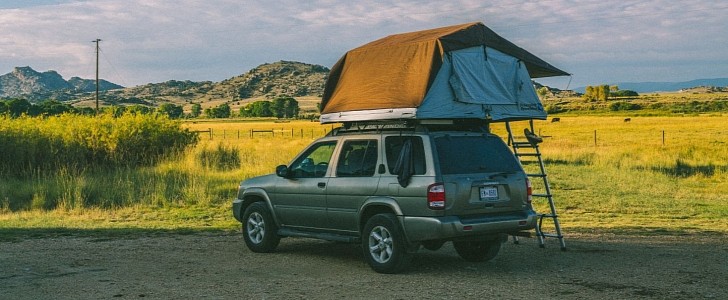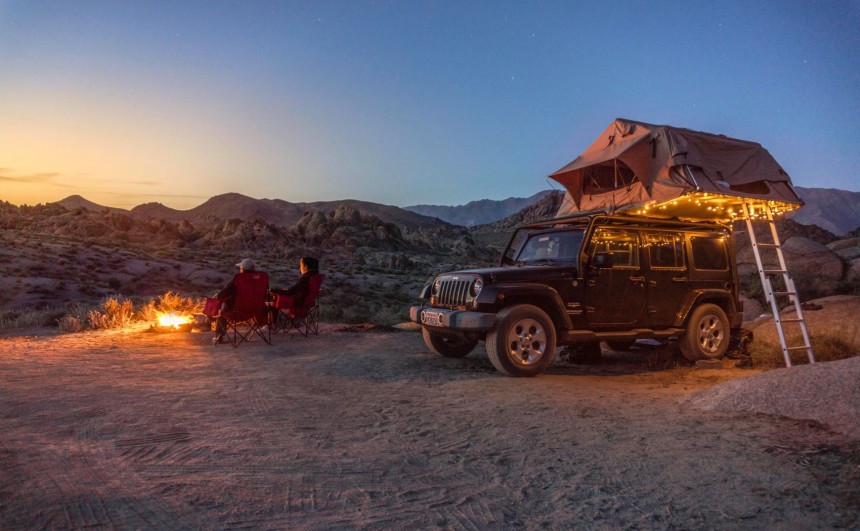Summer is in full effect, and most of us plan our next escape out of the urban jungle. If an extended camping trip is the first thing on your mind, a rooftop tent (RTT) would be a great addition to your vehicle. However, choosing the right one is not an easy process, so here’s what you should consider before you buy one.
In recent years, RTTs have grown in popularity for many reasons. The most obvious one is that they fit atop your vehicle, so its cargo space won’t have to suffer. Furthermore, due to their construction, setting up is easier and faster than regular ground tents.
There are many options out there, so the prices vary accordingly. A cheap and relatively small one can cost anywhere between $1,500 and $2,000, but a larger version built for hardcore overlanding can be more expensive than a brand-new car.
My advice is to check out the websites of various manufacturers like Thule, iKamper, Roofnest, or any brand that has an online catalog, select your vehicle, and check out which variants are compatible.
When it comes to how far apart they should be fitted, a two-person tent requires a distance of 24 inches to 32 inches (61 to 81 cm), one for three people needs 32 inches to 48 inches (81 to 122 cm), while for a bigger, four-person tent the racks should be positioned 48 inches to 56 inches (122 to 142 cm) apart.
There are generally three types of RTTs to choose from, and they vary in terms of quality and convenience.
Soft roof tents are similar to conventional A-frame ground tents, with an internal pole and a nearly triangular shape. They are lightweight and usually cheaper than hard-shell models, but they can be difficult to maintain, dry and pop up, and collapse. Most manufacturers offer all the mounting hardware you need and a sturdy ladder that makes it easy to climb in.
Hard-shell tents are more expensive, but they’re sturdier, more versatile, and some are even aerodynamic, which leads to better fuel economy. Moreover, it’s easier to set up one of these since they pop up and collapse easily.
Now that you know the basics of rooftop tents, you can explore the available options and make the right choice. All that’s left is to go out there and enjoy the wilderness.
There are many options out there, so the prices vary accordingly. A cheap and relatively small one can cost anywhere between $1,500 and $2,000, but a larger version built for hardcore overlanding can be more expensive than a brand-new car.
Make Sure Your Vehicle Supports One
While RTTs will fit almost any four-wheeled vehicle with a fixed roof, they are not universal. Some models are designed for smaller cars, others for larger SUVs, and so on.My advice is to check out the websites of various manufacturers like Thule, iKamper, Roofnest, or any brand that has an online catalog, select your vehicle, and check out which variants are compatible.
You’ll Need Roof Racks
Before you go any further, you need to understand that you will need roof racks to mount a rooftop tent. Factory-installed variants are generally good, but if your vehicle doesn’t have any, or you plan to buy a bigger tent, you should consider a pair of sturdier aftermarket racks. Once again, established brands like Thule have an excellent configurator you can use for this purpose.When it comes to how far apart they should be fitted, a two-person tent requires a distance of 24 inches to 32 inches (61 to 81 cm), one for three people needs 32 inches to 48 inches (81 to 122 cm), while for a bigger, four-person tent the racks should be positioned 48 inches to 56 inches (122 to 142 cm) apart.
Soft Roof or Hard Shell
Soft roof tents are similar to conventional A-frame ground tents, with an internal pole and a nearly triangular shape. They are lightweight and usually cheaper than hard-shell models, but they can be difficult to maintain, dry and pop up, and collapse. Most manufacturers offer all the mounting hardware you need and a sturdy ladder that makes it easy to climb in.
Hard-shell tents are more expensive, but they’re sturdier, more versatile, and some are even aerodynamic, which leads to better fuel economy. Moreover, it’s easier to set up one of these since they pop up and collapse easily.
Installing It by Yourself Is Extremely Difficult
Regardless of the type of RTT you decide to buy, installing it on your own is not impossible, but it requires ingenuity and muscle. You’ll find many videos with people using hoists or A beams, but to do it safely and conveniently, just ask a couple of friends to help. All the mounting hardware is included, so you’ll just need two wrenches and a little bit of patience. The whole process shouldn’t last more than an hour unless you brought a really complex model. Additionally, if your friends are too busy, some companies offer professional installation at their shops or warehouses.Now that you know the basics of rooftop tents, you can explore the available options and make the right choice. All that’s left is to go out there and enjoy the wilderness.











